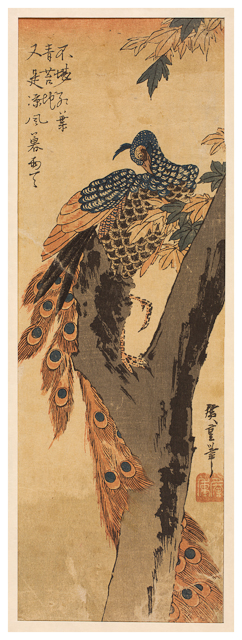
Maker(s): Utagawa Hiroshige I
Culture: Japanese (1797-1858)
Title: Peacock on A Tree
Date Made: c. 1835
Type: Print
Materials: Woodblock print (woodcut); Nishiki-e, Ink and color on paper
Place Made: Asia; Japan
Measurements: Mount: 17 3/8 in x 8 9/16 in; 44.1 cm x 21.7 cm; Sheet/Image: 13 5/16 in x 4 9/16 in; 33.8 cm x 11.6 cm
Narrative Inscription: SIGNATURE: recto, lwr. r. (black ink): [Japanese character, Hiroshige hitsu]; INSCRIPTION: recto, upp. l. (black ink): [pseudo Chinese character, Fujuri no ha / aogoke no/ matakore suzumi kaze / [ill.] [ill.]]; SEAL: recto, lwr.r. (red ink): [Japanese character, Hiroshige].
Accession Number: MH 1969.184.Q.RII
Credit Line: Gift of Mr. and Mrs. James Austin (Janet Evans, class of 1925)
While Hiroshige is best known for his landscapes, he is also a master of the Kacho sub-genre of ukiyo-e prints. Kacho prints are arrangements of birds and flowers that originated as a popular subject matter in the Japanese courtly school of painting that served the elite of society. Hiroshige uses the techniques of the Kano school of court painting, which is characterized by the lack of figural outlines, static or formal presentations of arranged outdoor scenes, and a schematized composition of pictorial elements. What is striking about this particular print is the contrast of the thick, darkly shaded branches of the maple tree with the delicate lines and bright colors of the peacock’s feathers. Even though there is no outward movement, the curve of the peacock’s tale feathers down and around the tree branch creates a dynamic composition that moves one’s eye through the print. Symbolically, the peacock represents opulence due to its exotic nature as an expensive, imported bird while the maple tree relates to the autumn season and signals that winter is coming.